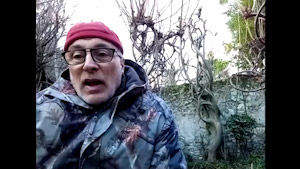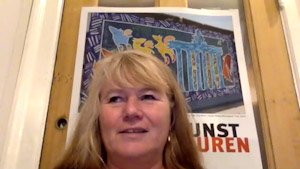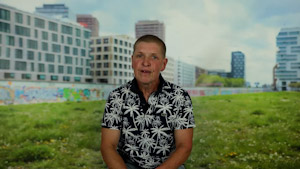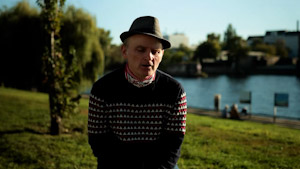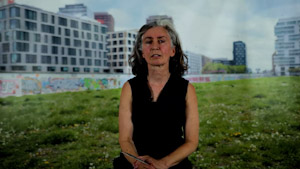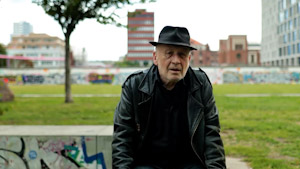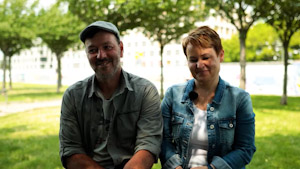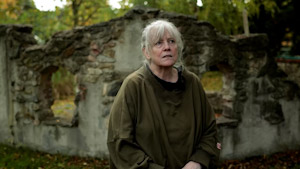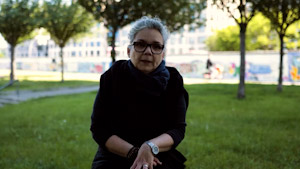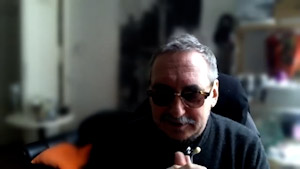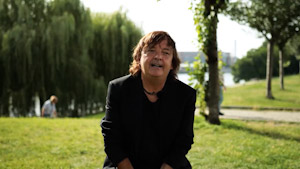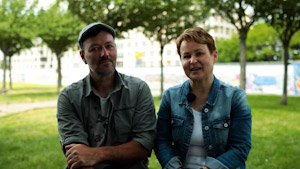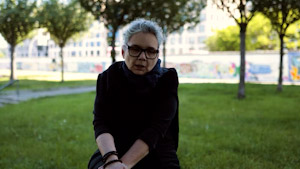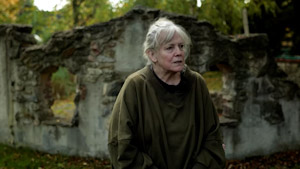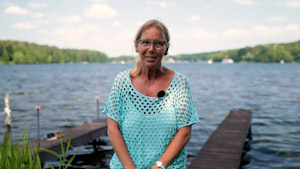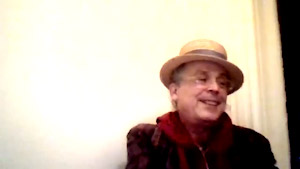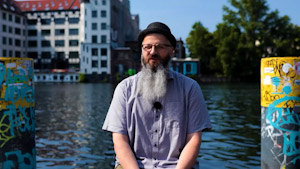Who are the East Side Gallery Artists?
Anyone who wanted to change the Wall with their art was welcome at the East Side Gallery. David Monty, East Side Gallery initiator, invited members of the East and West German artists' associations to participate. He also publicized his project in newspapers and on the radio. Some artists heard about it through word-of-mouth or from an acquaintance.
"We were all very happy; we were all very euphoric: Look, it’s fantastic! […] There was this euphoria; but then I thought: What am I painting here? How important is it? What is this background? What about the people who died … and then it became quiet."
The application procedure, however, was the same for everyone: artists had to submit mural sketches, which had to be approved by David Monty's assistant, Christine MacLean. There were also certain requirements that had to be met. The sketches had to reflect "the humanist spirit" as understood by the GDR Council of Ministers and they had to address themes of freedom, human rights or environmental protection. Yet some artists had been unaware of this procedure or had intentionally circumvented it. They wanted to paint the Wall spontaneously and without being asked to do so.
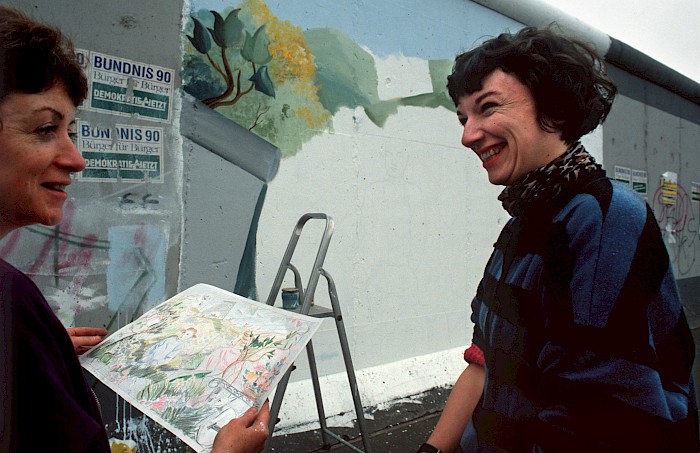
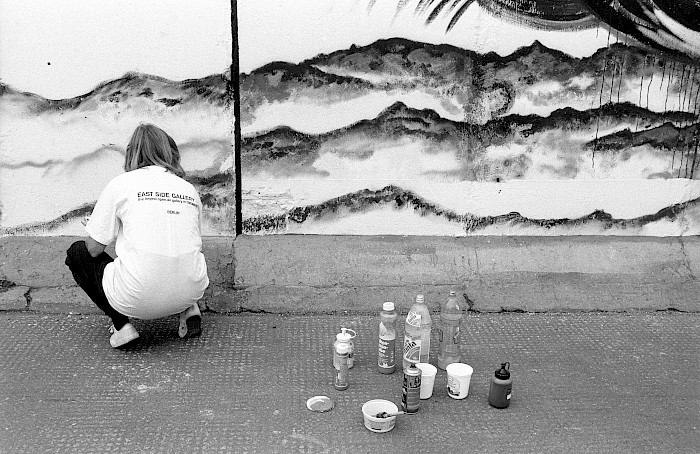
The artists came from 21 countries but most of them had been living in Berlin or Germany in 1990. Half lived in East Berlin or the GDR. The average age of the artists who painted the Wall was thirty. Some had studied or learned art and were making a living from it. Others had just started their careers and had never painted a large surface in a public space before. For others, this was the only public image they ever painted.
The Wall was painted by 118 artists from February to September 1990. A mural often took several days to complete because the exhaust fumes from the street made breathing at the site difficult. Many of those who worked in early 1990 often had conversations with the people standing in line along the Wall at the Oberbaum Bridge border crossing. Some even spoke with GDR border guards. But by autumn the situation had changed. Most artists now painted alone and had fewer opportunities to speak with passers-by. The first time all the artists met together was at the opening ceremony on 28 September 1990.
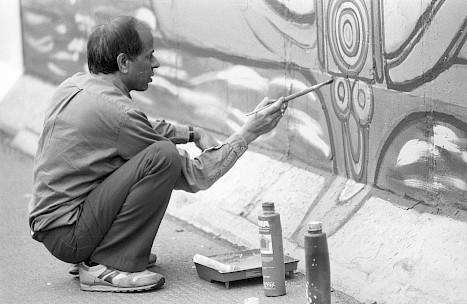
Preserving the East Side Gallery in 1990/91: The "Wuva," the Artists and the City Administration
In February 1990, David Monty, who had founded the "East Side Gallery GDR" together with Heike Stephan, received written permission from the GDR Council of Ministers to paint the Wall on Mühlenstraße. Thus began the art action that was to become the longest open-air gallery in the world. Soon thereafter, on 1 March 1990, the Friedrichshain district council signed a contract with the newly founded ad agency "Werbe- und Veranstaltungsgesellschaft GmbH," or "Wuva" for short, allowing them to use the same section of the Wall as advertising space. Thus, in spring 1990, two projects began on the Wall on Mühlenstraße with varying degrees of success: the artists worked slowly but steadily on their murals, but the advertising ambitions of Wuva were not welcome. Before they began their works, the artists had to remove posters that had been put on the Wall, many of which concerned the elections on 18 March 1990. The Wuva ended up joining the "East Side Gallery GDR" project.
In April 1990, David Monty withdrew from the "East Side Gallery GDR" project. His assistant, Christine MacLean, took charge of organizing the project. She reached a cooperation agreement with the Wuva and its managing director, Rainer Uhlmann. Wuva now supported the painting project financially and paid MacLean a salary. The agency also drew up contracts stipulating that the artists cede their marketing rights for the paintings to Wuva for five years. After their costs had been reimbursed, the artists would receive a one-time payment of 500 DM for their paintings. The Wuva also planned to take the Wall paintings on an international tour that would end with an auction, the proceeds of which would be shared with the artists. Some artists signed these contracts. The Wuva meanwhile organized the production and sale of postcards, T-shirts and other souvenirs with images of the artwork printed on them. The artists were meant to receive a share of these profits as well, but no payment was ever made to them. Moreover, only a very few ever received the 500 DM they had been promised for their paintings.
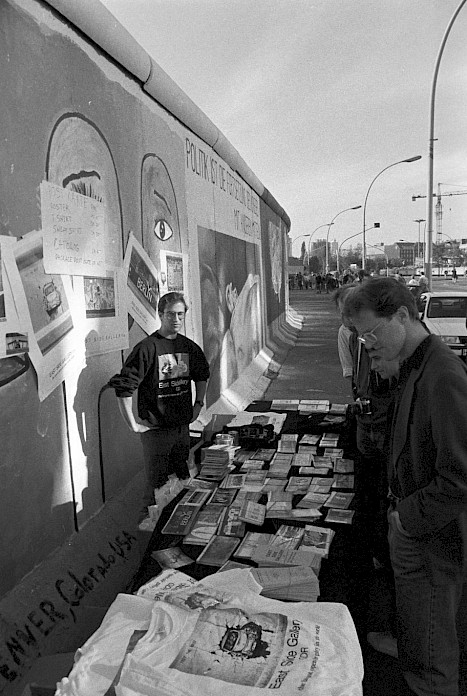
The East Side Gallery – Preserve It, Sell It or Move It?
The Wuva had big plans for the East Side Gallery, but it lacked the legal basis for a world tour and auction of the Gallery. Instead, the agency—in cooperation with Christine MacLean—tried to negotiate a new contract with the Friedrichshain district. These efforts were unsuccessful, however, because it was still unclear exactly who was actually responsible for this section of the former border. Furthermore, public internal discussions about whether to preserve, demolish or relocate the Wall were still too heated. The artists of the East Side Gallery were also divided. The "Mühlenstraße Wall Painters Interest Group," consisting of 12 artists, advocated for the preservation of the Wall, the self-determination of the artists, and a right of first refusal for the district. Although it supported the sale of individual parts of the Wall, the alliance rejected a tour and canceled the contracts with Wuva. Another group, the "Gallery Advisory Board," which consisted of six artists, members of the Wuva and a Senate representative, spoke out on behalf of the tour, but wanted the paintings returned to Berlin afterwards.
The Path to Historic Preservation
In late 1990, the district terminated its contract with Wuva. This, combined with a lack of funding, led the agency to abandon its plans for a world tour in April 1991. Instead, Wuva sought permission from the district to remove individual works of art from the Wall and sell them. Artist Fulvio Pinna actively opposed this in May 1991 by requesting that his artwork be protected as a historic monument. The district administration, meanwhile, was in favor of collaborating with the artists instead of with Wuva, leading to the creation of another artists' advisory board, which argued for keeping the East Side Gallery on Mühlenstraße. In June 1991, the Senator for Urban Development and Environmental Protection, Volker Hassemer, announced that the East Side Gallery would be granted protection as a historic monument. The East Side Gallery was added to the state’s historic preservation list on 15 November 1991, putting an end to any discussions about the (partial) sale of the artworks. Wuva withdrew its involvement.
Contemporary witnesses remember
Additional information:
Podcastfolge zum Umgang mit den Überresten der Berliner Mauer: Die Podcast-Reihe „Grenzerfahrung“ von der Stiftung Berliner Mauer entstand 2021 anlässlich des 60. Jahrestags des Mauerbaus und wurde gefördert von der Bundesbeauftragten für Kultur und Medien. Die Folge „Teilung – Einheit – Mauerspuren“ fragt nach dem Umgang mit den historischen Spuren der Teilung in Berlin. Expertinnen und Experten diskutieren über die Bedeutung der Spuren als Erinnerungs- und Bildungsorte, u.a. geht es um den Erhalt der East Side Gallery aus der Sicht der Stiftung Berliner Mauer und des Künstlers Günther Schaefer. In dieser Folge geht es außerdem um die Auswirkungen des Mauerfalls und des Vereinigungsprozesses auf Menschen, die als nicht Deutsch gelesen wurden. https://www.stiftung-berliner-mauer.de/de/stiftung/podcast-grenzerfahrung

